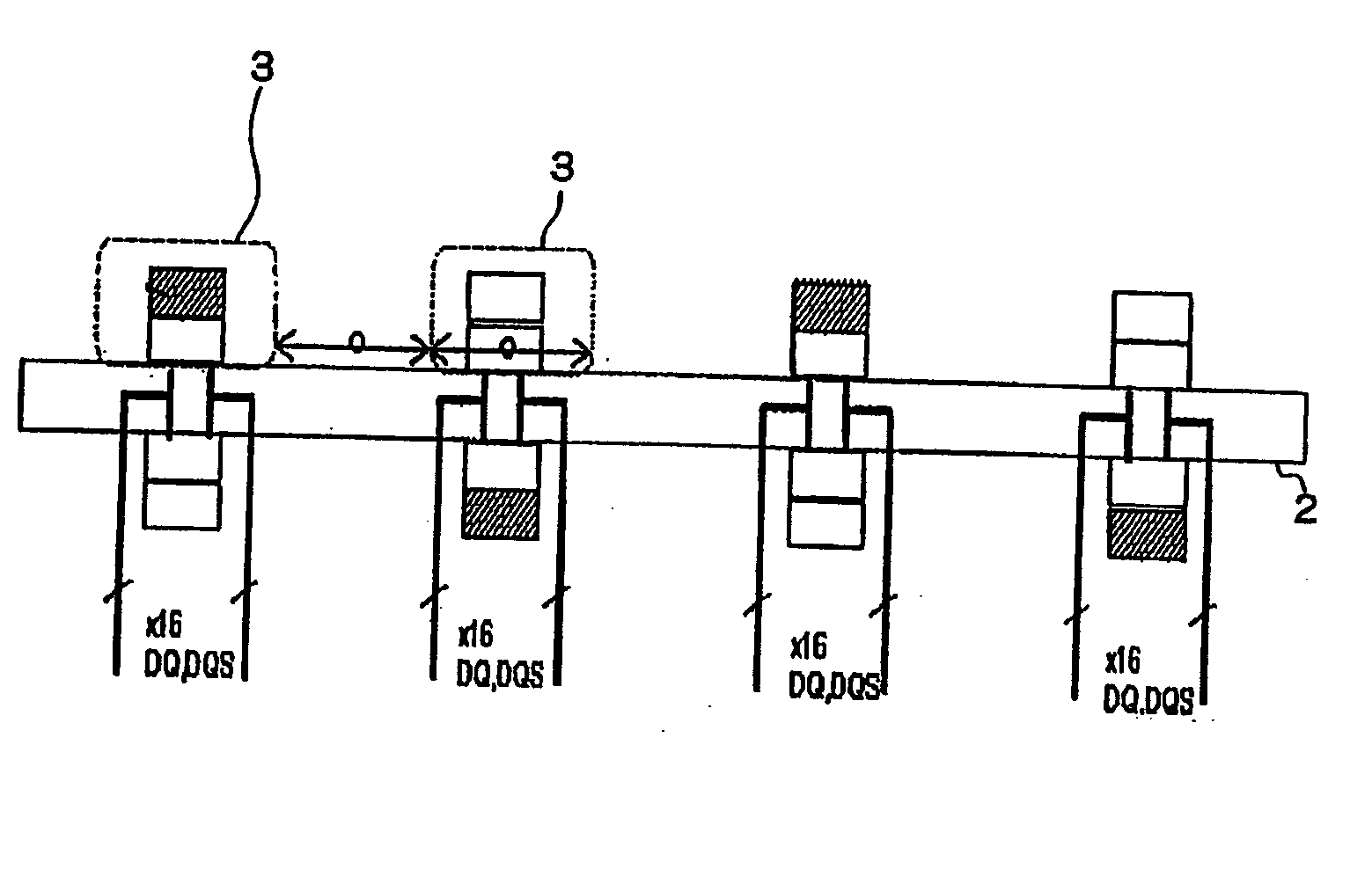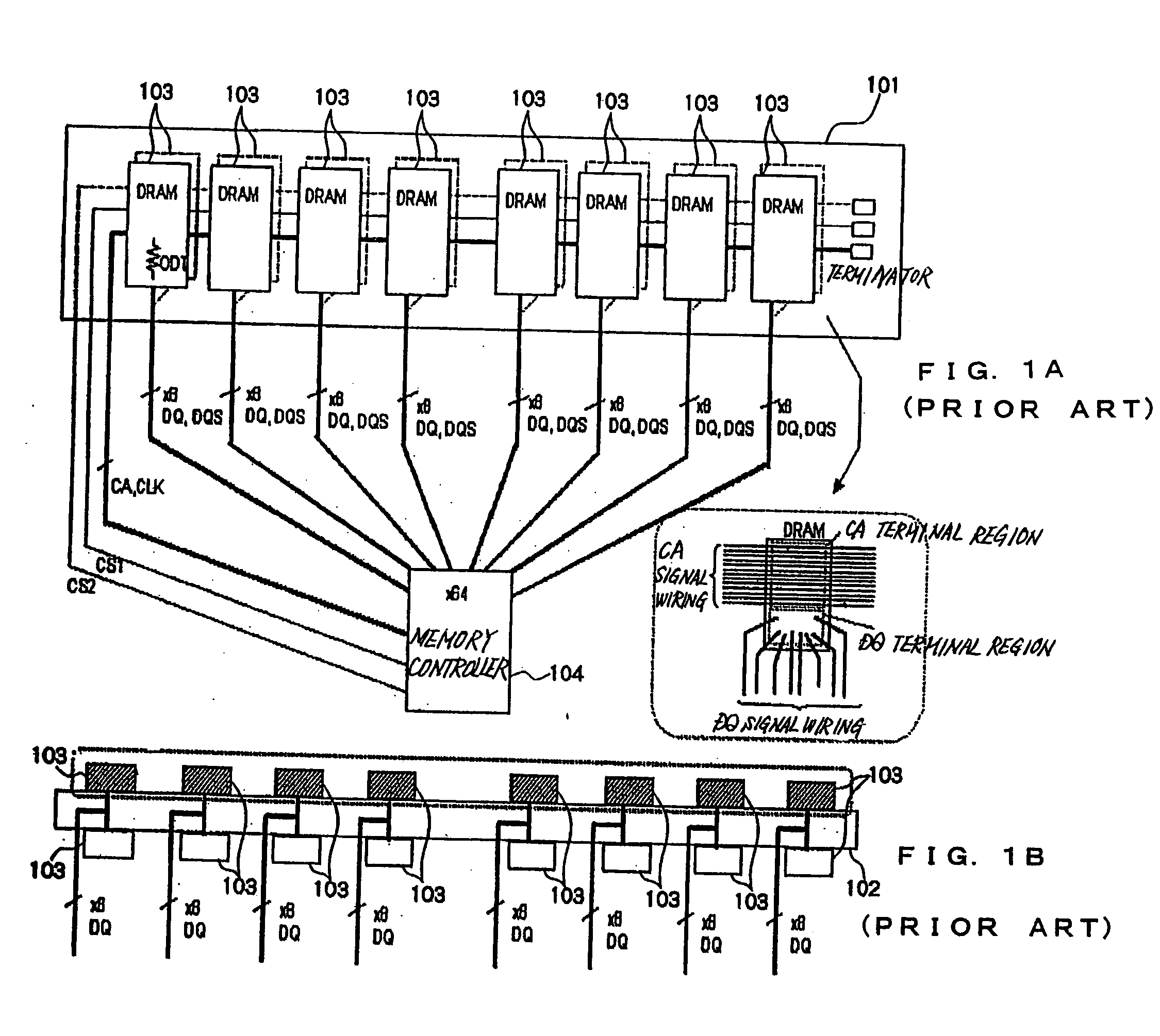Stacked memory, memory module and memory system
a memory module and memory technology, applied in the field of stacking memory, can solve the problems of short distance between wirings, inability to meet the needs of users, and memory performance to be degraded, and achieve the effect of low power consumption and high speed data transmission
- Summary
- Abstract
- Description
- Claims
- Application Information
AI Technical Summary
Benefits of technology
Problems solved by technology
Method used
Image
Examples
first embodiment
[0069] A memory module of a first embodiment is configured such that stacked memories are employed for memories to be mounted on a module substrate with two memories (memory chips) sharing signal terminals and the spacing between the stacked memories is widened to allow the degree of freedom in a DQ signal wiring to be ensured.
[0070] As shown in FIGS. 3A and 3B, memory module 1 of the first embodiment is mounted with sixteen memory chips and configured to have four ranks with 64-bit I / O. Memory module 1 is mounted with a total of eight stack memories 3, four stack memories 3 being mounted on each of the front and reverse surfaces of module substrate 2, wherein each stack memory 3 has a plurality of built-in memory chips (two memory chips in FIGS. 3A, 3B). Accordingly, the number of the memory chips amounts to sixteen. Each stacked memory 3 is provided with 16-bit I / O and each of the two memory chips incorporated in stacked memory 3 is also adapted for 16-bit I / O. The two memory chi...
second embodiment
[0080] In the memory module of the first embodiment, if an ordinary stacked memory as shown in FIG. 5A is employed as a stacked memory for mounting on a memory module, a load capacitance equivalent to four memories are connected to the daisy chain bus at prescribed intervals. Consequently, the characteristic impedance of the transmission line locally varies significantly so that a waveform of a signal carried by the daisy chain bus, such as the CA signal, might be deteriorated.
[0081] Stacked memory 300 shown in FIG. 5A is configured such that first memory chip 302 is mounted face down (with chip pad 309 directed downward) on package substrate 301 having BGA (BAII Grid Array: a group of ball terminals 305 arranged in an array) on the bottom face and second memory chip 303 is mounted face up (with chip pad 309 directed upward) on first memory chip 302 and fixed with sealing material 304.
[0082] Package substrate 301 has, for example, power-supply / GND (ground potential) layer 306 form...
third embodiment
[0104] As shown in FIG. 11, stacked memory 23 of a third embodiment is configured such that four memories 402 each provided with through holes 408 are mounted on package substrate (interposer) 401 having ball terminals (signal terminals) 405 for electrically connecting with the module substrate. A technology of stacking a plurality of memory chips on a interposer 401 as described above is called CoC (Chip-on-Chip), wherein each memory chip 402 and ball terminal 405 are electrically connected through via through holes 408 bored through memory chips 402 and signal wirings formed in interposer 401.
[0105] For reference, the CoC technology is explained in detail, for example, Y. Akiyama et al., “Superfine Pitch Ultrasonic Bonding Technology on 3D Stacked LSI”, ICEP (International Conferences of Electronics Packaging) Proceedings, pp.326-331, 2003., or K. Takahashi et al., “Current Status of Research and Development for 3D Chip Stack Technology” Jpn. J. Appl. Phys., Vol. 40(4B), pp. 3032...
PUM
 Login to View More
Login to View More Abstract
Description
Claims
Application Information
 Login to View More
Login to View More - R&D
- Intellectual Property
- Life Sciences
- Materials
- Tech Scout
- Unparalleled Data Quality
- Higher Quality Content
- 60% Fewer Hallucinations
Browse by: Latest US Patents, China's latest patents, Technical Efficacy Thesaurus, Application Domain, Technology Topic, Popular Technical Reports.
© 2025 PatSnap. All rights reserved.Legal|Privacy policy|Modern Slavery Act Transparency Statement|Sitemap|About US| Contact US: help@patsnap.com



